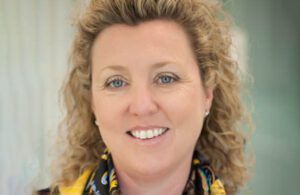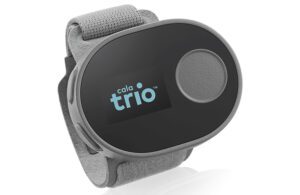
Cala Health co-founder and Chief Scientific Officer Kate Rosenbluth [Photo courtesy of Cala Health]
Cala Health co-founder Kate Rosenbluth developed a solution for essential tremors, a debilitating disorder that can make it difficult to perform daily tasks like drinking from a glass or writing checks.
A neuroscientist and engineer by training, Cala Health co-founder and Chief Scientific Officer Kate Rosenbluth saw the necessity for an easy treatment option for essential tremors while doing her biodesign fellowship at Stanford University.
She was performing observations at Stanford Hospital and clinics for several months, following neurosurgeons, neurologists, practitioners and any nurse that was willing to allow her to observe unmet needs in medicine. That’s when she noticed an opportunity to help patients in the field of essential tremor and hand tremor.
Essential tremor is a nervous system disorder that causes involuntary and rhythmic shaking. It most often occurs in the hands but can affect almost any part of the body, making simple tasks like drinking from a glass difficult. The disorder is not caused by other conditions and is often confused with Parkinson’s disease. Essential tremor is most common in people age 40 or older and affects more than 6.4 million people in the U.S., according to a study from the American Academy of Neurology.
Rosenbluth, who has an extensive background working in deep brain stimulation, was aware that the site of deep brain stimulation is accessible through peripheral nerves in the wrist. Through more research, Rosenbluth discovered that the same signals that cause tremors could be sent to the same location in the brain non-invasively by stimulating those nerves.
“This insight came out of realizing that functional neurosurgeons, when they were implanting the deep brain stimulators, will often sweep the sensory distribution of the hand to find that location in the brain,” Rosenbluth told Medical Design & Outsourcing.
Teaming up with co-founder Scott Delp, director of the Stanford Neuromuscular Biomechanics Laboratory, Rosenbluth began to reverse engineer the circuitry of movement disorders outside of the brain.
They brought another co-founder, engineer Serena Wong, onto the team to lead research and development. Together, along with CEO Renee Ryan who co-led the $18 million Series A fundraising round with Lux Capital, they started Cala Health in May 2014.

Cala Health CEO Renee Ryan [Photo courtesy of Cala Health]
“Clearly what Kate was doing in her early work while still at Stanford was a wearable wrist-like form factor, but it was responsive neuromodulation,” Ryan told MDO. “In that first meeting with her, I said, ‘Kate, we’re going to go start a company.’ That’s how we first came into touch with Cala Health.”
How Cala Health’s Cala Trio works
Cala Health’s flagship device is the Cala Trio, a wearable worn on the wrist to target the same site in the brain where tremor is well-controlled by deep brain stimulation (DBS) — the thalamus. Cala Trio is FDA cleared as an external upper limb tremor stimulator, available by prescription only.
Early on, the team found they could put motion sensors on the wearable to detect the speed of the tremor because oscillations in the brain are well-correlated to the speed of hand tremors.
“It’s typically between a slow tremor of about 4 Hz and a fast tremor of about 12 Hz,” Rosenbluth said. “So, we realized that onboard a single device, we could both measure the frequency or the speed of a patient’s tremor and deliver the electrical stimulation to treat the tremor. And by bringing those two areas of the individualized monitoring and calibrated stimulation into a wrist-worn form factor, we could offer patients tremor relief.”

The Cala Health Cala Trio [courtesy of Cala Health]
In developing the device, Cala Health also had to figure out the optimal timing of the stimulation needed to interrupt the tremor signal sent from the hand and the wrist and to the brain. That distribution was an indicator that the signal from the nerves that pass very close to the skin near the carpal tunnel would be able to send a signal to the same location in the brain as DBS, but non-invasively.
The company’s transcutaneous afferent patterned stimulation (TAPS) therapy sends patterned signals to the brain across the skin to stimulate the thalamus. The therapy can be individualized and measure how fast each patient’s tremor is to deliver a signal that alternates between the medial and radial nerves in the wrist at the same frequency of the tremor. It can bring tremor relief both during and after the stimulation.
Patients wear the device for 40-minute sessions throughout the day as needed. The FDA clearance does not limit the number of sessions per day.
“To me, what was really exciting about that is offering the therapy that is truly meeting patients’ needs,” Rosenbluth said. “They are looking for help with everything from eating, drinking, doing buttons, signing checks. What we really wanted to do was develop a therapy that was usable by different patients for tremor relief.”
Dr. Yasar Torres-Yaghi is a neurology physician specializing in movement disorders and co-investigator on a home-use study of Cala Trio.
“It’s not just about the clinical tremor benefit we see, but the quality of life changes and the different functional impact — being able to hold things, for example, all the things that essential tremor can affect,” Torres-Yaghi said. “Telling [patients] that those things that they are doing might be able to improve with non-pharmacological therapy does open their eyes. You can see very happily surprised looks in patients’ eyes.”
A future in treating central nervous system conditions
Cala Health aims to use the noninvasive therapy in treating other conditions. It recently received FDA breakthrough device designation for expansion into hand tremors associated with Parkinson’s disease.
“As we saw increasing success in growing our healthcare professional confidence in our technology and also the patients’ receptivity to the wearable technology, this year we are likely to 4X our sales footprint, so we’re going to be growing revenue substantially over the next few years,” Ryan said.
In some of Cala Health’s larger clinical studies, there were tens of thousands of data points of individual sessions by individual patients that could be captured and measured noninvasively to treat essential tremor, Rosenbluth said. Using that information, the company is focusing on indications where a peripheral nerve can be stimulated to signal into the central nervous system and have physiological signals that calibrate the stimulation to get the best possible efficacy for a patient.
“It’s really interesting when you look at these sort of platform technologies where I deeply believe that by bringing together areas of physiologic monitoring and of stimulation, critically we think of this sort of as sensing and treating. That’s what was so beautiful about tremor as a first place to start,” Rosenbluth said. “You could use the same motion sensors that are used onboard the device to calibrate the stimulation and measure someone’s tremor and actually measure efficacy on a per patient, per dose.”